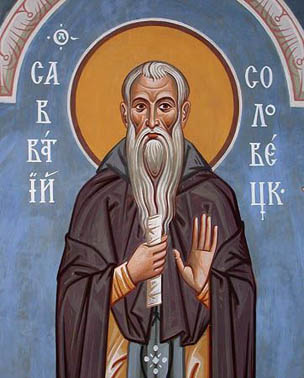
The Monk Savvatii of Solovetsk
Commemorated on September 27 and August 8
The Monk Savvatii of Solovetsk came to the Kirillo-Beloezersk monastery in the year 1396, where he took monastic vows. He there pursued asceticism for a long time, unquestioningly fulfilling all obediences. His humility, gentle love towards the brethren and his strict life distinguished the monk Savvatii among his fellow ascetics. He soon became burdened by the attention and esteem of the brethren and laity coming to him, and having learned that on Lake Ladoga is the rocky island of Valaam, he decided to settle there. Quite sadly, the brethren of the Kirillo-Beloezersk monastery were parted from their starets (elder). At Valaam the worldly fame likewise began to disquiet the humble starets. Amidst this the monk learned, that in the North was the uninhabited island of Solovetsk, and he began to ask of the hegumen blessing to settle there in solitude. But the hegumen and the brethren did not want to be separated from their holy starets-elder. At the command of God the Monk Savvatii by night left the Valaam monastery and set off to the shores of the White Sea. When he learned from the local people that the island was situated at a two-day voyage, that on it were many lakes and that on the island no one lived, he all the more was embued with the desire to settle there. The astonished local people asked the ascetic, whitened with grey hair, how he would live there and what he would eat. "My Master is such, – answered the monk, – Who unto frailty giveth the fresh strength of youth, and nourisheth to fullness the hungry".

For a certain while
the Monk Savvatii remained at the chapel, set nearby the mouth of the Vyg
River, in the environs of Soroka. There he encountered the Monk German –
pursuing asceticism as an hermit, and together they decided to settle upon the
island. In a frail boat, praying to God, the elders set off upon the harsh sea
and after three days they reached Solovetsk Island. The ascetics settled by the
Sekirna hill, where they raised up a cross and made their cells. In the severe
conditions of the North the startsi-elders over the course of several years by
their exploits hallowed the unpopulated island. And here likewise the enemy of
mankind – the devil, tempted the holy elders. A certain fisherman with his
wife, moved with a sense of envy, came somehow to the island and settled not
far from the ascetics. But the Lord did not permit the laypeople to maintain
themselves alongside the elders. Two youths in bright garb appeared to the wife
of the fisherman and struck at her with rods. The fisherman took fright,
quickly gathered his things and hastened to return to his former place of
residence.
Once, when the Monk
German had gone for cell-necessities off along the Onega River, the Monk
Savvatii – remaining alone and sensing his impending end, with prayer turned
to God, that He would grant him to commune the Holy Mysteries. The monk sailed
for two days to the mainland and at ten versts from the Vyg River encountered
the hegumen Nathanael, who had come to the distant settlement to commune a sick
Christian. Hegumen Nathanael rejoiced at meeting the monk, fulfilled his wish
and heard the account about his exploits on the island. In parting, they agreed
to meet at the church along the Vyg River.
Entering the temple,
the holy elder prayerfully gave thanks to God for Communion. He then enclosed
himself in a cell located nearby the church, and began to prepare himself for
hermitage in the eternal habitation. During this time the Novgorod merchant
John came to shore and, having venerated the holy icons in church, he went to
the holy elder. Having received blessing and guidance, he offered the monk a
portion of his wealth and was saddened, when he heard a refusal. To comfort the
merchant, the Monk Savvatii offered him to stay over until morning and promised
him prosperity on further journeying. But the merchant John hastened to
disembark. Suddenly there began an earthquake and on the sea a storm picked up.
Having taken fright, the merchant stayed, and in the morning when entering the
cell for a blessing, he saw that the elder was already dead. Together with the
just-arrived hegumen Nathanael, they buried the Monk Savvatii at the chapel and
compiled a manuscript of his life. This occurred on 27 September 1435. After 30
years the relics of the Monk Savvatii were transferred by the Monk Zosima
(+ 1478, Comm. 17 April) and the brethren of Solovetsk Island, placing
them in the Transfiguration church. In 1566 the relics of the Monks Savvatii
and Zosima were transferred into a church, named in their honour (combined
Commemoration 8 August).
© 1996-2001 by translator Fr. S. Janos.